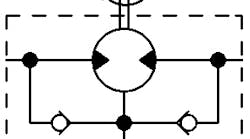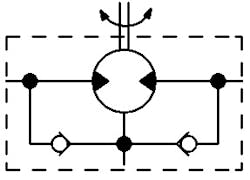When Hydraulic Motor Case-Drains Are Optional—Unless You Want Reliability!
As you're hopefully well aware, an unrestricted case-drain line is essential on a piston-type hydraulic motor, whether it's axial, radial or bent-axis design. But when it comes to gear designs—external, internal and gerotor, a case-drain line is generally considered optional. This is because these types of motors don't have a large-volume case or sump like piston motors do. But they do have internal leakage which by design, usually accumulates in a small cavity just before the shaft seal.
In theory, by installing a high-pressure shaft seal and two check valves as shown in the picture below, internal leakage is drained into the return line (something that's not acceptable for a piston motor or pump). And this is why a dedicated drain line is usually considered optional.
But NOT if reliability is the foremost criteria, as Ian McKenna, a long-time Hydraulics Pro Club member from the UK, explains:"Part of a design modification we carried out to our fleet of drilling rigs required two low speed, high torque (gerotor) motors being installed on the front of the drilling rig to turn a shaft that housed wire rope brushes to clean the spoil from the drill string (auger). The early design was without case drains as the motors didn't require it according to the specification. However after several failed motors due to shaft seals leaking I suggested we fit case drains. It meant quite a bit of extra work and materials (hoses, brackets, fittings etc.) to return the oil back to tank but since then the problem has been eliminated. Any machines we carry out this modification to now includes a motor drain-line as standard." This issue is one of many apparent conflicts in hydraulics between what is OK to do, according to the component manufacturer, and what is best for optimum reliability. Another example that comes to mind is it's OK by most pump manufacturers to have the pump 'lift' its oil from the tank. In other words, to mount the pump above minimum oil level. HOWEVER, if you want the pump to have the best chance of lasting as long as possible you'll give it a flooded inlet (head of oil above the pump). Of course, there will always be exceptions to any rule. You may have a pump mounted above the tank that looks like it may very well rust away before it needs replacing. Or a gerotor motor without a dedicated drain-line that has never leaked from its shaft seal and doesn't look likely to. But the odd exception doesn't make the case for not following best practice. Especially if optimizing reliability is your primary concern.Bottom line: not installing an external case drain line on a gear motor can be a mistake. And to discover six other costly mistakes you want to be sure to avoid with your hydraulic equipment, get "Six Costly Mistakes Most Hydraulics Users Make... And How You Can Avoid Them!" available for FREE download here.


